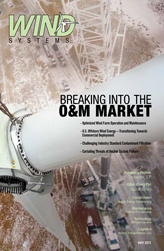It wasn’t so long ago that I witnessed paper service reports being stored at the base of a tower. For many organizations, things haven’t advanced far beyond that, with spreadsheets still being acceptable to some as a legitimate method of data storage.
In their 2011 study on Computerized Maintenance Management System (CMMS) usage, Reliabilityweb.com reported that almost half of all respondents believed there to be no return on investment from their CMMS. It’s a staggering statistic, but kind of understandable.
Why then, in a recent report for Sandia Laboratories, did Management Resources Group conclude that a good CMMS “can play a significant role in achieving critical goals” on wind farms?
The truth is that a quality, well-implemented CMMS is critical to any legitimate service division. It starts by viewing a CMMS as not just a repository for asset history, but as a tool that can streamline and control day-to-day facility management.
Backbone of a Service Division
A quality CMMS will permit all stakeholders, from technicians to service managers, from HR to the asset owners, to be in touch with the goings on of a facility, without having to necessarily be a power user. It should allow management to focus attention elsewhere and allow the system to do what it is supposed to do.
A CMMS should allow management to systematically manage workflow with consideration to the resources that are required. This not only means replacing the whiteboard of daily work with a more sophisticated and visible approach, but generally tying together key functions like safety, planning, troubleshooting, to mention but a few, in order to gain a holistic view of one or multiple sites.
The advent of Software as a Service (SaaS) is helping this happen, with CMMS users reaping the benefits of “anywhere, anytime” access, low start-up costs, reduced (and often eliminated) IT costs, painless, automated upgrades, and seamless integrations with other software including Enterprise Resource Planners (ERP’s). Application Programming Interfaces, or API’s, allow integrations to be established quicker and more easily than in the past. It also means that technicians are not spending time in front of big, clunky ERP’s.
As the industry somewhat ironically plays catch-up to older, more established ones, the shift in asset demographics following a construction boom period is forcing all stakeholders to reassess systems and procedures to reduce overheads and streamline operations. IHS business analysts report that operations & maintenance costs are expected to double to around $6 billion within 12 years. This means that asset owners need to get smart about knowing their assets now. For many of them this has been severely neglected in the past resulting in an overall lack of quality historical data upon which to not only judge service tenders, but to predict future maintenance costs as the assets age.
Herein lies an opportunity for service providers, be they the OEM or ISP, to use their CMMS to strengthen and enhance their relationship with their customer by way of data openness. Owners on the other hand need to ask themselves if they are sufficiently prepared ahead of time with a comprehensive, searchable asset history. It creates an environment whereby knowledge is retained regardless of staff changes or shift in O&M strategy by the asset owner.
Beyond SCADA
The benefits of SCADA are well documented, but what it can’t tell is what actually went wrong, what the actual cause of the fault was, how the issue was rectified and can consequently be prevented in the future. It doesn’t tell us what materials would be required if the same event occurred again, and what manpower would likely be called upon. Technicians and engineers tell us this, and a quality CMMS is the means by which that feedback can be stored and systematically called upon when and as required.
It therefore stands to reason that quality CMMS data will play an effective role going forward for troubleshooting, resource planning, and even design modification. The wind industry is really only scratching the surface of where the use of CMMS’s can drive efficiencies. They are undoubtedly the next frontier in predictive maintenance and performance enhancement as quality subjective and often anecdotal data is harnessed and turned into a powerful resource.
It’s impossible to predict the full extent to which CMMS data will be fully leveraged in the future. And yes, it is undoubtedly difficult to define a true return on investment of a CMMS. But perhaps instead of trying to determine ROI we should be asking if any legitimate service division can compete, both in service offering and in operational efficiencies, without this essential tool?
More info: www.maintainly.com


































